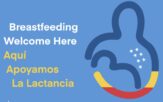As the first week of August comes to a close we wanted to take a moment to reflect and celebrate, World Breastfeeding Week (WBW). WBW was started in 1992 as a “global campaign to raise awareness and galvanize action on themes related to breastfeeding.”
This year’s theme, “Closing the Gap,” highlights the fact that there are still numerous gaps in education and care for lactating families. We know that breastfeeding and human milk provide a wide variety of benefits for babies and families. For the infant/child, these include lower incidence of ear infections, asthma, severe GI infections, and diabetes. Parental health can also improve by breastfeeding; lower risks of breast cancer, diabetes, and high blood pressure are among the many established benefits. Breastfeeding results in better community health, lower healthcare costs, and less absenteeism from work.
Despite the numerous benefits of human milk and breastfeeding, there are significant barriers that can interfere with breastfeeding. Some include lack of family support and inadequate education about breastfeeding. Cultural and social norms may influence whether parents breastfeed; parents may feel embarrassed or have their efforts undermined if the community norm is not to breastfeed. Difficulties with breastfeeding, such as low supply, pain, and mastitis, may cause people to stop breastfeeding if they don’t have healthcare providers and peer support to help them through. Childcare challenges and work situations can be barriers. Understanding the barriers can help to identify solutions and interventions to improve breastfeeding/lactation duration and exclusivity.
These barriers can result in low levels of breastfeeding self-efficacy (BSE). Self-efficacy is a person’s level of confidence in their ability to plan and carry out actions to achieve a specific result. BSE includes a parent’s level of confidence in their capability to breastfeed (e.g., the choice to breastfeed, how much effort they will put into it, how much they will persevere through challenging times, and how they will handle it all emotionally, with self-defeating vs. self-enhancing thoughts). Higher BSE results in higher rates of initiation and longer duration of breastfeeding/lactation. BSE can be improved by addressing some of the above-listed barriers that interfere with breastfeeding.
Strategies could include…
- Providing early and repeated education about the physiology and benefits of breastfeeding and human milk
- in childhood, this should be part of the educational curriculum
- for birthing people and their families, education should begin pre-pregnancy and continue prenatally and postpartum; when relevant, information should be given about other ways to provide human milk if feeding at the breast or chest is not desired or possible (donor milk, bottles, nursing supplementers, etc.), or the option of inducing lactation if non-birthing parents desire this
- Normalizing breastfeeding/human milk feeding; when it is done in homes and in public places, people learn that breastfeeding is the norm in their communities and should not be hidden or discouraged
- Educating parents about when and where to ask for help when they have problems or concerns
- Increasing access to peer support groups, lactation consultants, and other healthcare providers who have expertise in breastfeeding
- Enacting and enforcing Baby Friendly Hospital policies and creating more Breastfeeding Friendly medical practices
- Improving education about breastfeeding and lactation for healthcare providers and allied health professionals
- Enacting and enforcing legislation to protect breastfeeding in public and in the workplace
- Ensuring that employed parents have dedicated time and a clean, safe space to express milk and/or breastfeed during working hours
- Ensuring that childcare centers and other caregivers have accurate information about safe storage and handling of human milk, and of the benefits that milk provides
To increase breastfeeding self-efficacy, parents and families need more knowledge about breastfeeding/lactation and the rationale for feeding their babies human milk, whether directly from the mammary glands or via a bottle or supplementer. They need more support and encouragement from friends and family, community, peer supporters, and knowledgeable professionals (IBCLCs, Breastfeeding/Lactation Medicine physicians, and other healthcare providers). They need supportive employers and childcare providers, and they need access to help when they have concerns.
As lactation healthcare providers and peer-to-peer supporters, we have an obligation to work toward removing barriers and closing the gaps in lactation-related care.
Together, we can work on Closing the Gap, normalizing breast/chest/human milk feeding, and improving breastfeeding self-efficacy by providing more comprehensive lactation support and protection for all.

